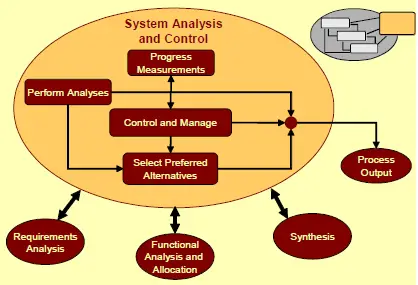System Analysis and Control manages and controls the overall Systems Engineering Process. This activity identifies the work to be performed and develops the schedules and costs estimates for the effort. It coordinates all activities and assures that all are operating from the same set of requirements, agreements, and design iteration. It’s the center for configuration management throughout the systems engineering process. [1]

System Analysis and Control (see Figure Above) interacts with all the other activities of the Systems Engineering Process. It evaluates the outputs of the other activities and conducts independent studies to determine which of the alternate approaches is best suited to the application. It determines when the results of one activity require the action of another activity and directs the action to be performed. The initial analyses performed in this activity are the basis for the Systems Engineering Plan (SEP) and the systems engineering entries in the Integrated Master Plan (IMP) which define the overall systems engineering effort. From the SEP and IMP, the Integrated Master Schedule (IMS) is developed to relate the IMP events and SEP processes to calendar dates. [1]
As the process progresses, trade-off studies and system/cost-effectiveness analyses are performed in support of the evaluation and selection processes of the other activities. Risk identification / Risk Mitigation studies are conducted to aid in Risk Management. Analyses also identify critical parameters to be used in progress measurement. The management activity directs all operations and also performs Configuration Management (CM), Interface Management (IM) and data management (DM). It specifies the performance parameters to be tracked for progress measurement. It conducts reviews and reports progress. [1]
The information from System Analysis and Control is a major part of the systems engineering process database that forms the process output. The analysis activity provides the results of all analyses performed, identifies approaches considered and discarded, and the rationales used to reach all conclusions. The selected preferred alternatives are recorded with the associated criteria and methodology for selection. [1]
– Step 1: Requirements Analysis
– Step 2: System Analysis and Control
– Step 3: Functional Analysis Allocation
– Step 4: Design Synthesis
AcqLinks and References:
Updated: 7/15/2021
Rank: G1
